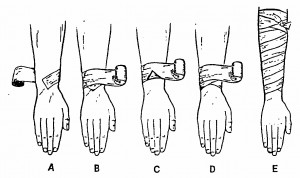An elastic roller bandage can be applied to a limb to compress the blood vessels and help control bleeding.
The bandage also provides support for damaged muscle tissues. A three-inch wide roller bandage is normally used for wrapping the forearm, arm, or calf (lower leg). When wrapping the thigh, a wider bandage (four to six inches wide) is normally used.
a. Expose the limb and check the circulation at a point below the point of injury, such as the wrist or foot.
b. Position the body part to be bandaged in a normal resting position (position of function). The body part should be as clean and dry as possible.
c. Lay the end of the bandage on the bottom of the limb to be wrapped and at an angle so one corner (apex) of the bandage will not be covered when the bandage is brought around the limb (figure 2-26 A).

d. Wrap the bandage completely around the limb twice and past the apex (figure 2-26 B).
e. Fold the apex over the bandage (figure 2-26 C) so that it lies on top of the bandage.
f. Continue wrapping the bandage around the limb a third time, covering the apex with the turn. The bandage is now anchored.
g. Wrap the limb in a spiral manner (figure 2-26 D). On each turn, overlap about one-third of the previous turn. Keep the bandage tight enough to apply pressure to the limb, but not tight enough to impair blood circulation.
h. Continue wrapping until the entire portion of the limb has been wrapped.
i. Secure the wrap with two circular turns at the top of the limb portion being bandaged. Then tape, clip, or tie the end of the bandage in a position that is easy to reach (figure 2-26 E).
j. Check circulation below the bandage. If blood circulation was not impaired before the bandage was applied but is now impaired, loosen the bandage and apply the bandage again.
